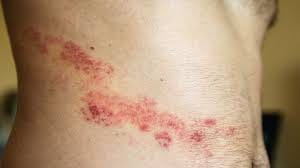Living With Shingles
This post is more beneficial for those past the age of 60, as that is when the disease is likely to occur.
Shingles (Herpes Zoster) is an infection which can attack the body at any time. Although it’s more likely to occur during times of low immunity, such as during a cold or a fever or because of a spell of stress, extreme or otherwise, so you need to be on the alert even when you’re in reasonably good health. According to statistics, 1 in 3 people past the age of 60 get the disease at some stage
What are the symptoms?
A tingling, a bit like pins and needles, a throbbing and jabbing sensation, which usually spreads diagonally across the right side of the body from the abdomen to below the armpit to the beginning of the back.
About one to three days later, a rash in a pattern of blotches and patches as a band breaks out where you felt the sensations. Needless to say, they’re acutely uncomfortable and painful and can last from several weeks to a few months.
Although there’s no cure which can also disupt your sleeping patterns, there are measures you can take to try and alleviate the symptoms.
Take some medication such as Vaclivovir or Gabapentin tablets about 3 times a day.
If ointment is preferable, Vaclivovir has this as an alternative to tablets, but none of these are really effective.
Its better to take cold showers on a daily basis to cool the inflammation.
If you get a particularly sensitive area such as hard or bumpy skin, then wear lose cotton clothing for awhile which will reduce the friction you will feel or get some soft adhesive patches which will further reduce or cushion the frictional contact from to the clothing.
Above all, drink plenty of water each day to flush out toxins from the body.
If you’ve been eating junk or processed food, try to pack them in and eat healthy foods such as vegetables and natural foods as much as possible. Needless to say, avoid sugary and soda drinks, alcoholic drinks, salty, and sweet foods, etc, although peanuts are a safe bet.
Take supplements which also help.
Above all, get plenty of sleep, relaxation, and do moderate walking or other exercise for at least thirty minutes a day which will address the immune system and combat any stress that might come along.
Best of luck during the recovery process. The pain becomes less and less and the rash band does fade but there are no quick fixes even when you act within the recommended 72-hour time limit from the disease breaking out.
And there’s no cure except to follow the above advice to aid recovery and prevent the painful attack and rash outbreak from occurring again.

